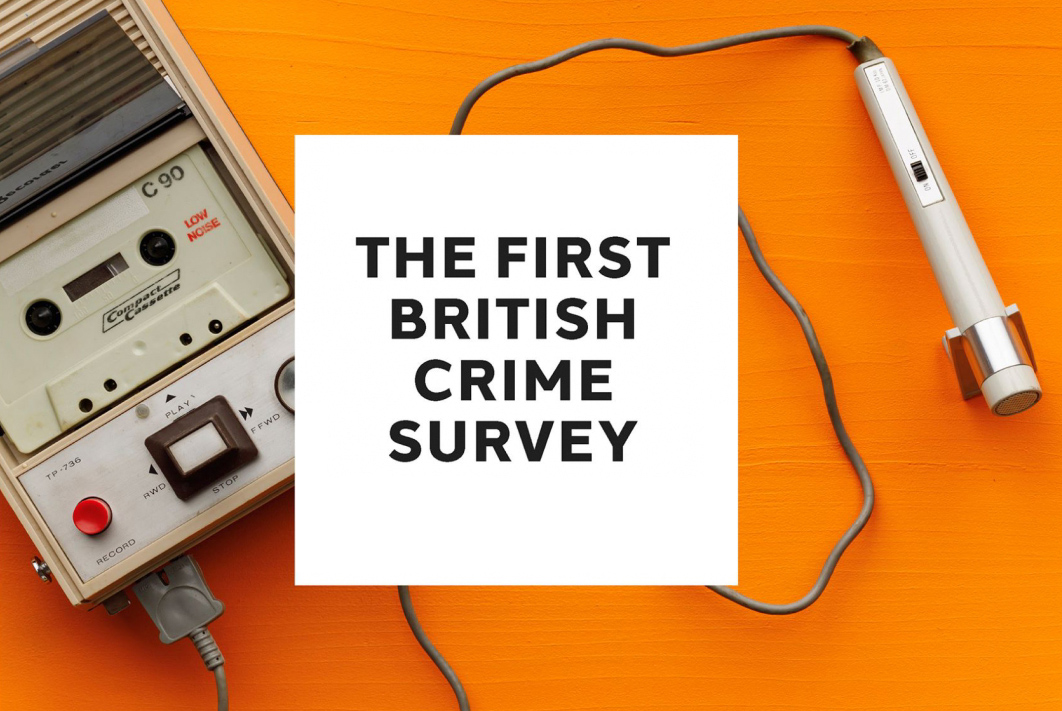
Julian Molina
The publication of the first British Crime Survey in 1983 represented a significant breakthrough for understanding crime patterns. For the Home Office, the survey aimed to address a ‘crisis’ in British crime statistics. It used survey techniques and expertise to address long-standing concerns about the quality and accuracy of police-recorded crime statistics. Today, the survey has evolved into the Crime Survey for England & Wales and, according to one of the survey’s original designers, it is a ‘juggernaut mainly concerned with administrative procedures.’
In this blog, I want to draw out some features of the British Crime Survey’s early history to suggest what these can illuminate about the relationships between Home Office mandarins, criminologists, and international networks of survey researchers. This is a grouping that has been whimsically referred to as the ‘crime survey’ circus. This blog is based on some findings in my recently published book, The First British Crime Survey: An Ethnography of Criminology Within Government, which revisits this episode to understand the history of administrative criminology in Britain. The book explores the institutional negotiations and methodological deliberations that enabled this survey and what it can tell us about the foundations of criminology’s data infrastructures.
The ‘Crime Survey’ Circus goes to Cambridge
To undertake the survey, Home Office officials drew upon the expertise of an international network of survey researchers within academia and international governments. This ‘crime survey’ circus comprised experts and researchers from Canada, the Netherlands, Germany, the US, and the UK (Molina, 2023). This grouping was an important movement in supporting the spread of crime surveys in the 1970s and 1980s (van Dijk and Castelbajac, 2015). Some key events were influential in establishing this network, such as the Villa Serbelloni conference in Bellagio in 1975 that brought together a community of research professionals. Meetings like these fostered a burgeoning network of collaboration and the exchange of ideas and methods. One former official told me this conference was ‘like a ten-day unbelievable boondoggle with a load of Americans and Europeans who were interested in victimology’ (Molina, 2023).
Another influential event was a conference organized by Hans Joachim Schneider, a World Society of Victimology founder, in Munster, Westphalia, in the late 1970s. At this conference, one researcher within the Home Office, Pat Mayhew, met Wes Skogan, a leading figure in survey research in the United States (Molina, 2023). At that conference, emerging results from various national surveys were shared, including those from the USA, Finland, Netherlands, and Switzerland (Home Office, 1981). Through such events and this burgeoning informal network of public officials, criminologists, and survey researchers, members of this circus came to play an important role in the ‘persuasion game’ that initiated the British Crime Survey (Molina, 2023).
Early in 1981, while Home Office policy officials prepared proposals for a National Crime Survey, political events were a concern for then Home Secretary William Whitelaw (Whitelaw, 1989). Home Office officials were preoccupied with the public’s perception of the government’s record on crime and ‘inner city’ riots in England (Peplow, 2019; Tuck, 1981). The perennial rise in police-recorded crime levels was also a key concern to Home Office officials (Walklate, 2015). And, that spring, the Home Office’s Crime Policy Planning Unit organized a three-day workshop in a ‘leafy’ Cambridge College, hoping to get other officials to relax in a familiar environment and discuss their proposals for the National Crime Survey (Molina, 2023). The proposal would, they argued, estimate the ‘dark figure of crime’. The workshop gathered the views of crucial UK Departmental officials, academic criminologists from the UK and the US, administrators from Canada, Germany, and the Netherlands, and representatives from the police inspectorate and HM Treasury (Home Office, 1981).
At the workshop, divergent views emerged between criminologists, who generally supported the survey, and administrators, who sought immediate policy relevance (Molina, 2023). The Dutch Ministry of Justice presented its experience with a similar survey, emphasising that most crimes had little impact on victims (Molina, 2023). Before this event, Home Office officials had thoroughly briefed international criminologists and survey experts invited to the event to argue how the survey should be conducted (ibid). It should, in short, be done by survey researchers and not statisticians. As such, the workshop offered an occasion for persuasion and friendly, well-briefed survey experts from the circus were tasked with endorsing the Home Office’s view of how and why to undertake the survey (ibid).
Home Office Mandarins and Well-Mannered Hostility
During the design phase of the survey, the Statistical Department, Police Department, and Home Office Research and Planning Unit (HORPU) engaged in a series of meetings, letters, and memos to discuss the draft survey instrument (Molina, 2023). Outside of the deliberations between Home Office mandarins, researchers and statisticians discussed what form the survey should take. There was a great degree of ‘well-mannered hostility’ between HORPU and the Statistics Department officials (ibid). Former HORPU officials characterized the Statistical Department as ‘part of the enemy’ (ibid). Their written exchanges were designed to undermine each other’s arguments and credibility (ibid). At that time, the cross-government ‘Rayner Review’ of statistics had initiated swinging cuts to the budgets of Home Office statisticians, cutting staff numbers, the size of published reports, and aligning its products with ‘customer needs’ (Rayner, 1980).

Image 1. The Home Office Statistical Department (Maurice, 1985).
Despite being seen as antagonists to HORPU researchers, the Home Office Statistical Department actively participated in discussions to design the survey counting rules, sample selection, incident forms, and self-reported criminality questions (Molina, 2023). Home Office statisticians complained about the survey’s methodological limitations, arguing that the sample size and coverage made the National Crime Survey incomparable to police statistics (ibid). These statisticians were critical of the ‘whole venture’ (ibid). However, its officials also noted that they engaged in open discussion and worked at ‘enhancing the overall proposals’ (ibid).

Image 2. The National Crime Survey’s Victim Form, 1982 (Wood, 1984).
There were conflicts over sampling decisions, such as determining the reporting period for victims of crime and considering options such as a recall period of thirteen or fourteen months or incidents within a specific calendar year (Molina, 2023). Special provisions were made for non-English speakers, allowing their inclusion if someone in the household could serve as an interpreter (ibid). Representatives from the Statistics Department were particularly concerned about the survey’s adherence to Home Office counting rules (ibid). Across each of these areas of methodological debate, conflicts centred on questions of method but also extended to a broader change as to which professional group could account for crime levels within the government.
Crime Data in Times of Crisis
A better understanding of such inter-professional conflicts would enable a more critical sensibility to understand criminology’s current and future dilemmas. In the context of debates about the rolling crisis of empirical social sciences and crime data, brought about by Big Data, machine learning, and predictive analytics, criminologists are being invited to join new partnerships with industry and government to tame these ‘bleeding edge’ technologies. And, in the early 1980s, though the crime survey was seen as a ‘threat’ to statisticians’ domain of expertise, methodological conflicts between Home Office researchers reflected structural changes to the status and legitimacy of statistical expertise, research professions, and crime data.
We need more interdisciplinary and historical accounts of past crises to understand the current state of British criminology. In the early 1980s, severe financial constraints within the Home Office statistical community, brought about by cost-cutting saving exercises, diminished the status of statistics across government. Today, at a time when the British Crime Survey’s successor, the Crime Survey for England and Wales, is being ‘transformed’, we should be asking how these changes reflect new challenges to the status of criminological expertise, research professions, and what the public and criminology can, and should, do with crime data. We need to unearth hidden negotiations within government and between research communities to better understand the history of crime data (Cf. Ruppert and Sheel, 2021). We can do this by drawing from inventive, critical approaches which reflect on the history of censuses, spatial analytics, and neighbourhood surveys. Doing so would enable criminology to revisit its role in past crises and enable a more critical understanding of the history and future of its data.
References
Home Office (1981a) Report of a Workshop Held at Sidney Sussex College, Cambridge, 6-8 April 1981. London: Home Office Crime Policy Planning Unit.
Maurice, R. (1985) The Home Office Statistical Department. Statistical News, August (70). Central Statistical Office: HMSO Quarterly.
Molina, J. (2023) The First British Crime Survey: An Ethnography of Criminology Within Government. Bingley: Emerald Publishing Limited.
Peplow, S. (2019) Race and Riots in Thatcher’s Britain. Manchester: Manchester University Press.
Rayner, D. (1980) Review of Government Statistical Services: Report to the Prime Minister. London: Central Statistical Office.
Ruppert, E. and Scheel, S. (eds.) (2021) Data Practices: Making up a European People. London: Goldsmiths Press.
Tuck, M. (1981) Ethnic Minorities, Crime and Policing: A Survey of the Experience of West Indians and Whites. London: HMSO.
Walklate, S. (2015) Jock Young, left realism and critical victimology. Critical Criminology, 23(2): 179–190.
Whitelaw, W. (1989) The Whitelaw Memoirs. London: White Lion Publishing.
Wood, D. (1984) British Crime Survey, 1982: Technical Report. London: HMSO.
van Dijk, J. and Castelbajac, M. (2015) The hedgehog and the fox; the history of victimisation surveys from a Trans-Atlantic perspective, in N. Guzy, C. Birkel and R. Mischkowitz (eds.), Viktimisierungsbefragungen in Deutschland, Band 1, Ziele, Nutzen und Forschung [‘Victimisation Surveys in Germany, Volume 1, Aims, Benefits and Research’] BKA, pp. 10–29.
About the author
Julian Molina is Lecturer in Public Policy at the University of Bristol. He works on the intersections of social studies of social science, administrative criminology, government research and its data infrastructures. He is working on projects related to the history of computational social science, justice analytics, and racial knowledge production.
Contact
Julian Molina
University of Bristol
Julian.molina@bristol.ac.uk
This article gives the views of the author, not the position of the British Society of Criminology or the institution they work for.


You must be logged in to post a comment.